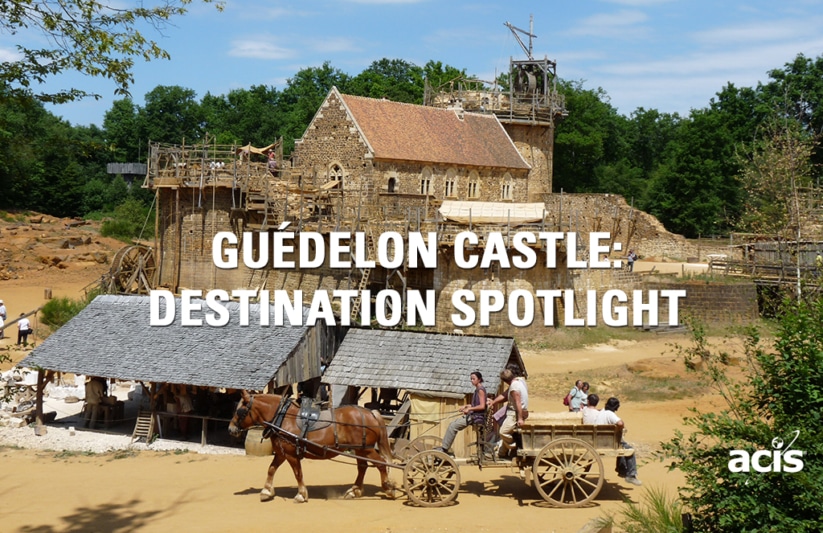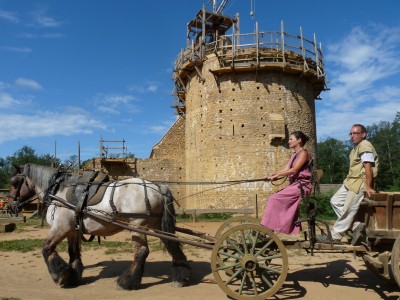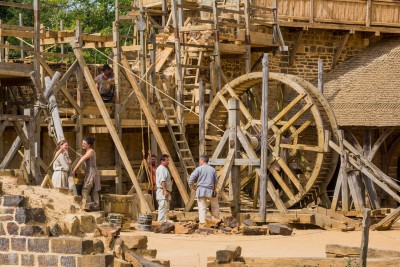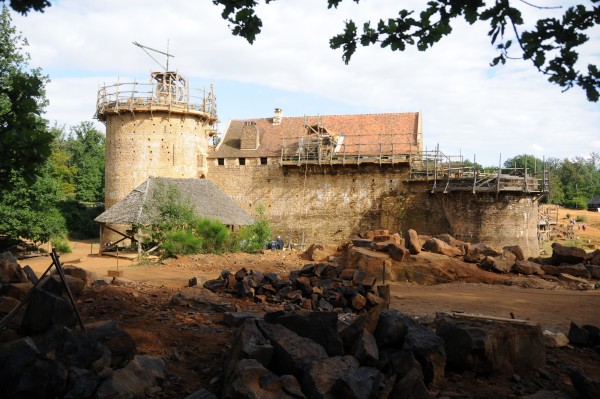Guédelon Castle: Destination Spotlight

This is the fourth in a series of articles profiling destinations new to our 2017 catalog.
Have you ever happened upon a medieval structure like a castle or a cathedral and thought to yourself, “How did they build something so huge without modern equipment?” Well, if you’ve ever wanted to find out, there may be no better opportunity than visiting Château Guédelon, a vast historical experiment, in which a team of enthusiasts is attempting to recreate a medieval castle, from scratch, using only 13th-century building techniques.
 What was once an abandoned stone quarry in Burgundy, two hours south of Paris, is now a teeming worksite that transports visitors back to the 13th-century. 100% of the materials that go into the project come from the surrounding area – including those needed to construct the tools. Rope made of hemp, wood blocks and structures made from the surrounding forest of oak trees and sandstone mined from the nearby quarry are the only materials used throughout the construction site. Even the workers are costumed in 13th-century garb.
What was once an abandoned stone quarry in Burgundy, two hours south of Paris, is now a teeming worksite that transports visitors back to the 13th-century. 100% of the materials that go into the project come from the surrounding area – including those needed to construct the tools. Rope made of hemp, wood blocks and structures made from the surrounding forest of oak trees and sandstone mined from the nearby quarry are the only materials used throughout the construction site. Even the workers are costumed in 13th-century garb.
The imaginary time and place that set the social context for Guédelon are medieval Burgundy in the year 1228. The rest of the historical backstory (as taken from Guédelon’s website) is as follows:
Louis IX, the future Saint Louis, was crowned in Reims three years earlier in 1226; too young to rule, his mother, Blanche of Castile, acted as Regent until 1235. Locally, Puisaye is under the control of Jean de Toucy. To the south-east lies the county of Auxerre-Nevers, controlled by Mahaut de Courtenay; in the north, the Capetian lands of Gâtinais. On the eve of the sixth crusade, Puisaye is enjoying a period of relative peace and stability.
The builder of Guédelon castle is Guilbert, a fictional low-ranking local lord, vassal of Jean de Toucy, himself vassal to the king of France. His overlord has just granted him “licence to crenellate”. His modest status in the feudal hierarchy and his limited financial means, prompt him to raise a “small” castle, a fortified manor house, far removed from the scale of the royal castles of the Louvre in Paris or Brie-Comte-Robert in Seine-et-Marne.
Jacques Moulin was the head architect tasked with drawing up the plans for Guédelon. He wrote a thesis on 13th-century French architect Pierre de Montreuil and the architecture of the era. His vision for Guédelon castle was that it should be both a visitor attraction and a place of genuine research into the techniques employed in the construction of historical buildings. The aim at Guédelon would not be to simply produce a finished castle, but rather to observe, in the finest detail, each phase of the construction.
Guédelon provides a fantastic opportunity for students of medieval French history to learn experientially. Short of inventing a time-machine, how else could students drop themselves into the middle of a 13th-century construction site? Not only can visitors sample 13th century snacks like pork shank, honey cake and scrambled egg with a garlic-giblet confit, the construction site is set up to welcome volunteers looking to help with the project themselves. If they’re not up for manual labor, they could always simply strike up a conversation (en français) with one of the workers to learn more.
Traveling through Europe, it’s easy to find one’s self walking in the footsteps of a noble or a famed explorer, eliciting a feeling of being transported back in time. It’s a magical feeling, but one that requires a sense of imagination and suspended belief. Guédelon takes that magical process one giant step further and creates a unique and transformative atmosphere unto itself. If you’re looking for an experiential learning opportunity for your students, it doesn’t get any more immersive than this.
Check out the complete itinerary for Guédelon Castle and Countryside, our tour featuring Guédelon along with visits to Paris, Bourges, Sarlat-la-Canéda and Tours!











